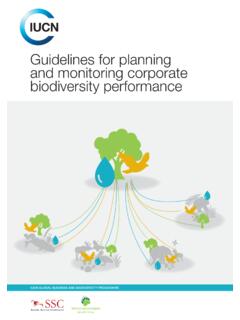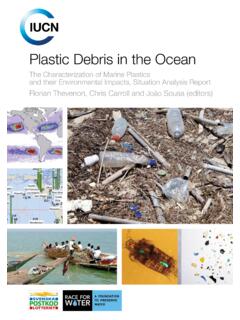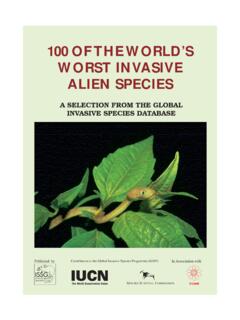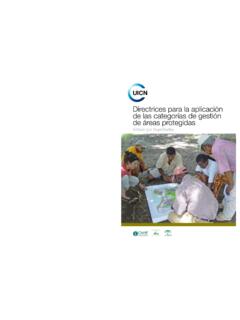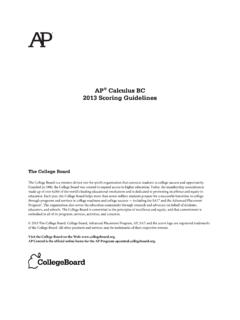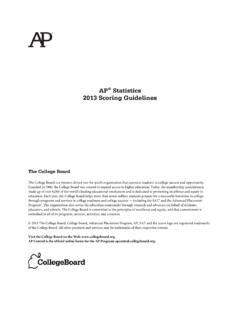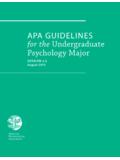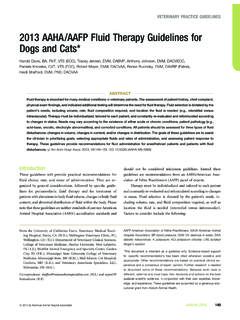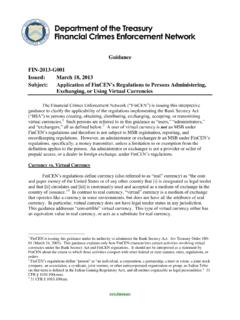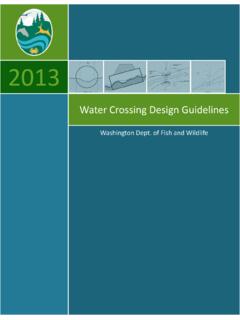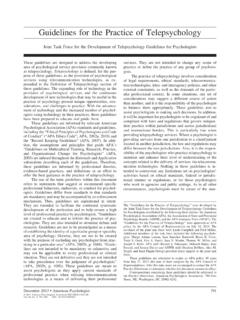Transcription of Guidelines for Reintroductions and Other Conservation ...
1 Guidelines for Reintroductions and Other Conservation Translocations Version Reintroduction and Invasive Species Specialist Groups' Task Force on Moving Plants and Animals for Conservation Purposes Guidelines for Reintroductions and Other Conservation Translocations Version Guidelines for Reintroductions and Other Conservation Translocations The Reintroduction and Invasive Species Specialist Groups' Task Force on Moving Plants and Animals for Conservation Purposes Version The designation of geographical entities in this document, and the presentation of the material, do not imply the expression of any opinion whatsoever on the part of IUCN or the organizations of the authors and editors of the document concerning the legal status of any country, territory, or area, or of its authorities, or concerning the delimitation of its frontiers or boundaries.
2 The views expressed in this publication do not necessarily reflect those of IUCN. Production of these Guidelines and Annexes was made possible through the generous support of the Environment Agency Abu Dhabi, in providing design services. The work of the Reintroduction and Invasive Species Specialist Groups' Task Force on Moving Plants and Animals for Conservation Purposes was funded by Al Ain Zoo, Abu Dhabi, and the Karl Mayer Foundation. Working meetings of the Task Force were generously hosted by Al Ain Zoo, Abu Dhabi. KARL MAYER STIFTUNG. Citation: IUCN/SSC ( 2013 ). Guidelines for Reintroductions and Other Conservation Translocations. Version Gland, Switzerland: IUCN Species Survival Commission, viiii + 57 pp.
3 ISBN: 978-2-8317-1609-1. Cover design and layout by: Mohamed bin Zayed Species Conservation Fund Cover photos: Anti-clockwise from top right: Seychelles White-eye (Zosterops modestus) Mikhail Shlemov Pygmy Loris (Nycticebus pygmaeus) Ulrike Streicher Chiricahua Leopard Frog (Lithobates [Rana] chiricahuensis) Abigail King Ifach Campion (Silene hifacensis) Emilio Laguna Field Cricket (Gryllus campestris) Dave Clarke Philippine Crocodile (Crocodylus mindorensis) Merlijn van Weerd Available on line at: Contents of Guidelines Acknowledgements Executive summary Guidelines Section 1 Introduction and scope of Guidelines Section 2 Definitions and classification Section 3 Deciding when translocation is an acceptable option Section 4 Goals, objectives and actions Planning a translocation Monitoring programme design Exit strategy Section 5 Biological feasibility Feasibility and design Social feasibility Regulatory compliance Resource availability Section 6 Risk assessment Section 7 Selecting release sites and areas Release and implementation Release strategy Section 8 Monitoring Monitoring and continuing Continuing management management Section 9 Dissemination of information Figure 1.
4 The translocation spectrum Figure 2. The Conservation translocation cycle V. 7. Acknowledgements These Guidelines and their Annexes development, both within the Species Survival were developed by a Task Force of the Commission and further afield both within and Reintroduction and Invasive Species Specialist outside IUCN. We thank all the individuals Groups, working between 2010 and 2012. and organisations that provided critiques and The Chair of the Species Survival Commission, feedback, all of which was carefully assessed. Dr Simon Stuart, appreciated that IUCN's 1998 We list all reviewers below. The finished Guidelines for Reintroductions needed review Guidelines and Annexes cover a wider array of and revision and the Chair of the Reintroduction situations and solutions, with their opportunities Specialist Group, Dr Fr d ric Launay, offered and risks, than the 1998 Guidelines .
5 Hence, the resources of the Reintroduction Specialist review and revision were entirely justified, and Group to carry out this task. He, in turn, invited the Task Force hopes that this contribution will Dr Mark Stanley Price to assemble and manage promote and help responsible translocation a small Task Force for the work. It soon became as an essential tool for Conservation in the evident that the Invasive Species Specialist present era of acute challenges for the world's Group contained expertise of direct relevance biodiversity. to the work, and its Chair, Dr Piero Genovesi, wholeheartedly brought in his Specialist Group. Task Force members The Task Force members are listed below. Mark R Stanley Price (Chair), Fr d ric Launay, Collectively, we would like to thank Simon Piero Genovesi, Doug Armstrong, Sarah Stuart for his initiative and Fr d ric Launay, Dalrymple, Wendy Foden, Peter Hollingsworth, Chair of the Reintroduction Specialist Group Michael Jordan, Michael Maunder, Ben Minteer, and Director-General, Mohamed bin Zayed Axel Moehrenschlager, Sanjay Molur, Fran ois Species Conservation Fund, for his invitation Sarrazin, Philip Seddon, Pritpal Soorae.
6 And support of the work. We are most grateful to the Al Ain Zoo for its support to the Task Task Force Associates Force Chair, for meeting all travel costs and Philip Hulme, Richard Kock, Richard Reading, Other costs associated with hosting three very David Richardson, Sophie Riley, James Watson. productive meetings of the Task Force at Al Ain Zoo. We extend out thanks to the Chief Guidelines reviewers Executive, Mr Ghanim Al-Hajeri, to Mr Binod We gratefully acknowledge the constructive Narasimhan, Ms Lisa Banfield, Mrs Hessa input from many organisations and individuals, Al-Qahtani and Mrs Muna Al-Dhaheri, and Dr especially: Urs Breitenmoser, Peter Bridgewater, Michael Maunder. The Task Force Chair was Rob Brooker, Andrew Burbidge, Rosie Cooney, further supported by the Karl Mayer Foundation.
7 Pam Cromarty, Mary Davies, John Ewen, We thank the Mohamed bin Zayed Species Philippe Feldmann, Werner Flueck, Marge From, Conservation Fund, for supporting the Martin Gaywood, Merryl Gelling, Adam Grogan, designing of the Guidelines and Annexes, Markus Gusset, Matt Hayward, Baz Hughes, and also Mrs Lynne Labanne, Marketing Jonathan Hughes, Robert Jenkins, Brian Jones, and Communications Officer of the IUCN Patrick Kelly, Robert Kenward, Tony King, Emilio Global Species Programme for directing the Laguna, Torsten Langgemach, Rebecca Lee, Guidelines through to publication. The Task Kati Loeffler, David Lucas, David Lusseau, Force drew on the specialist expertise on a Joyce Maschinski, Leonie Monks, Greg Mueller, number of Associates who contributed wisdom Simon Nally, Terry O'Connor, Herbert Prins, and insights to the Guidelines : they are listed Lydia Robbins, Ian Robinson, Karin Schwartz, below.
8 The Task Force members were afforded Mark Schwartz, Debra Shier, Claudio Sillero, time to work on the Guidelines by their home Diane Skinner, Patrick Todd, Hern n Torres, institutions, and we are all grateful for this Frank Vorhies, Grahame Webb, Liz Williamson. contribution in the interests of Conservation . Finally, the Guidelines and Annexes were reviewed widely and thoroughly during their VI. Guidelines For Reintroductions and Other Conservation Translocations Version Executive summary Executive summary Conservation translocation is the Translocations of organisms outside of deliberate movement of organisms their indigenous range are considered from one site for release in another. to be especially high risk given the It must be intended to yield a numerous examples of species measurable Conservation benefit at released outside their indigenous ranges the levels of a population, species subsequently becoming invasive, often or ecosystem, and not only provide with massively adverse impacts.
9 Benefit to translocated individuals. Any translocation will impact and be Conservation translocations - Figure 1 - impacted by human interests. Social, consist of (i) reinforcement and economic and political factors must reintroduction within a species' be integral to translocation feasibility indigenous range, and (ii) Conservation and design. These factors will also introductions, comprising assisted influence implementation and often colonisation and ecological replacement, require an effective, multi-disciplinary outside indigenous range. team, with technical and social expertise representing all interests. Translocation is an effective Conservation tool but its use either on its own or in Design and implementation of conjunction with Other Conservation Conservation translocations should solutions needs rigorous justification.
10 Follow the standard stages of project Feasibility assessment should include design and management, including a balance of the Conservation benefits gathering baseline information and against the costs and risks of both analysis of threats, and iterative the translocation and alternative rounds of monitoring and management Conservation actions. adjustment once the translocation is underway - Figure 2. This ensures Risks in a translocation are multiple, that process and progress are affecting in many ways the focal species, recorded; changes in translocation their associated communities and objectives or management regime ecosystem functions in both source can then be justified, and outcomes and destination areas; there are also can be determined objectively.
